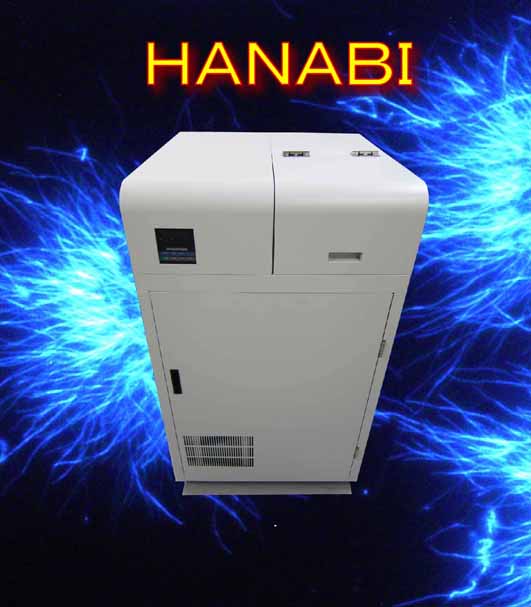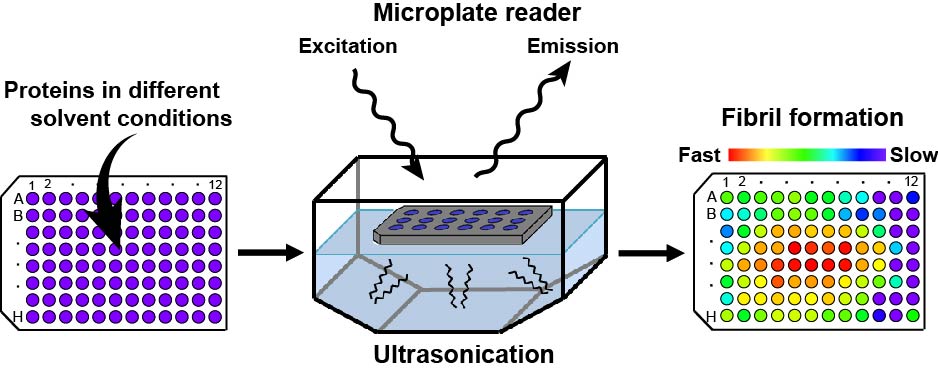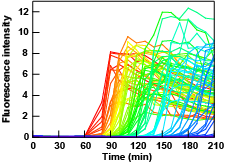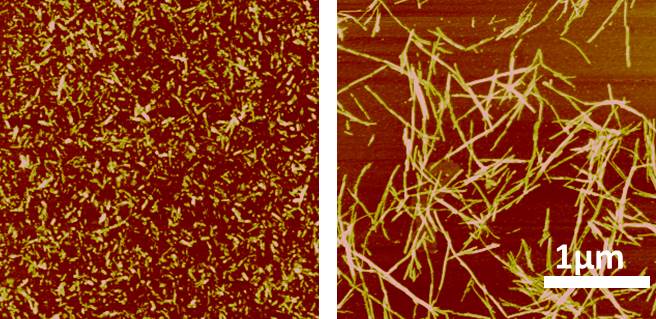
HANABI (HANdai Amyloid Burst Inducer)
A HANABI system, in which a fluorescence microplate reader is combined with a water-bath-type ultrasonicator, was developed for a high-throughput assay of accelerated amyloid fibrillation. After a certain period of ultrasonic irradiation, the microplate is moved automatically to the microplate reader, which monitors fluorescence or light scattering. By repeating this process, the system enables simultaneous and automatic multi-sample measurements of amyloid fibrillation. Moreover, the HANABI system will be powerful for a high-throughput screening of any types of the supersaturation-limited association of solutes.

UltrasonicatorELEKON+Microplate readerCORONA ELECTRIC
Amyloid fibrils are formed by a variety of proteins associated with more than 30 degenerative disorders including Alzheimer’s disease, prion disease, type II diabetes, light chain amyloidosis and dialysis-related amyloidosis. In addition, various proteins not directly associated with diseases can form amyloid fibrils under particular conditions. This indicates that a large proportion of proteins have a potential to cause amyloidosis. These series of observations argue the necessity for studying genome-wide the amyloidogenicity of proteins. However, the search for amyloidogenicity in experiments has been limited.
We found that ultrasonication is useful for accelerating spontaneous fibrillation of proteins. Ultrasonication generates the repeated growth and collapse of cavitation bubbles and concomitant large shearing forces. Although ultrasonication has been mostly used to break down preformed fibrils, it can also agitate a supersaturated solution of amyloidogenic proteins leading to a decrease in the high energy barrier to nucleation and thus formation of amyloid fibrils. We recognize that the ultrasonication is one of the most efficient agitations for generating amyloid fibrils from the supersaturated solution. Here, by combining a microplate reader and ultrasonicator, we developed HANABI (HANdai Amyloid Burst Inducer) for a high-throughput assay of amyloid fibrillation.
Supersaturation is a phenomena common to various physical and biological processes including protein crystallization, actin polymerization, and various types of lithiasis. HANABI will be revolutionary equipment for assessing potentials of these processes.

 |
 |
|
| Time course of the formation of fibrils in 96 wells monitored using ThT fluorescence | AFM images of β2microglobulin fibrils with (left) or without (right) ultrasonication |
Amyloid formation on a 96-well plate |
||
|
|
|
Simultaneous detection of the formation of amyloid fibrils of several kinds of proteins |
Acceleration or inhibition of the formation of amyloid fibrils by additives |
|
|
|
|
References
※HANABI was developed by a joint cooperation of ELEKON Co.,Ltd., CORONA ELECTRIC Co.,Ltd. and Osaka University, supported by Kansai Bureau of Economy, Trade and Industry.